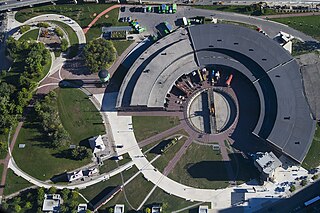
A railway roundhouse is a building with a circular or semicircular shape used by railways for servicing and storing locomotives. Traditionally, though not always the case today, these buildings surrounded or were adjacent to a turntable.

Eureka is a side-wheel paddle steamboat, built in 1890, which is now preserved at the San Francisco Maritime National Historical Park in San Francisco, California. Originally named Ukiah to commemorate the railway's recent extension into the City of Ukiah, the boat was built by the San Francisco and North Pacific Railroad Company at their Tiburon yard. Eureka has been designated a National Historic Landmark and was listed in the National Register of Historic Places on April 24, 1973.
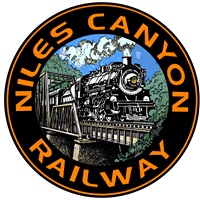
The Niles Canyon Railway (NCRy) is a heritage railway running on the first transcontinental railroad alignment through Niles Canyon, between Sunol and the Niles district of Fremont in the East Bay of the San Francisco Bay Area, in California, United States. The railway is listed on the National Register of Historic Places as the Niles Canyon Transcontinental Railroad Historic District. The railroad is operated and maintained by the Pacific Locomotive Association which preserves, restores and operates historic railroad equipment. The NCRy features public excursions with both steam and diesel locomotives along a well-preserved portion of the First Transcontinental Railroad.
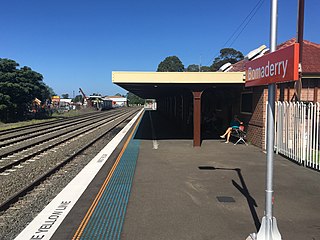
Bomaderry railway station is a heritage-listed single-platform intercity train station located in Bomaderry, New South Wales, Australia, on the South Coast railway line. The station serves NSW TrainLink diesel multiple unit trains to Kiama. Early morning and late night services to the station are provided by train replacement bus services. A siding near the station is used by freight trains operated by the Manildra Group.

Eagle Island is an island in Maine's Casco Bay and the site of the retirement home of the polar explorer Admiral Robert Peary (1856-1920). The island and home are preserved as the Eagle Island State Historic Site.

The Boca Chita Key Historic District is a U.S. historic district within the Biscayne National Park in Miami-Dade County, Homestead, Florida. Located on the northwest section of Boca Chita Key, delimited by Biscayne Bay in the north and west and a half ruined stone wall on its southern side, it contains three historic buildings and the Boca Chita Lighthouse. On 1 August 1997, it was listed in the National Register of Historic Places for its architectural, historical and recreational values.

Rockland Harbor Breakwater Light is a historic lighthouse complex at the end of the Rockland Breakwater in the harbor of Rockland, Maine. Replacing a light station at Jameson Point, the light was established in 1902, about two years after completion of the breakwater. Now automated, it continues to serve as an active aid to navigation. The light was added to the National Register of Historic Places as Rockland Breakwater Lighthouse on March 20, 1981.
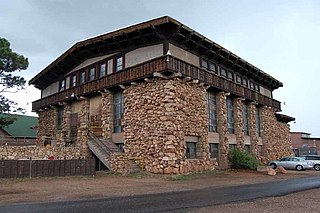
Grand Canyon Power House is a former electric power plant that served National Park Service and concessioner facilities at the South Rim of the Grand Canyon in Grand Canyon National Park. It is significant for its architecture, which masks the building's industrial function behind a veneer of rustic design. It has been designated a National Historic Landmark on the basis of its design quality and the level of preservation of its equipment.

West Concord station is an MBTA Commuter Rail station located in West Concord, Massachusetts. It is served by the Fitchburg Line. The station has two side platforms serving the line's two tracks, with mini-high platforms for accessibility. The adjacent station building, now a restaurant, is not used for railroad purposes.

The Georgia State Railroad Museum is a museum in Savannah, Georgia located at a historic Central of Georgia Railway site. It includes parts of the Central of Georgia Railway: Savannah Shops and Terminal Facilities National Historic Landmark District. The complex is considered the most complete antebellum railroad complex in the United States. The museum, located at 655 Louisville Road, is part of a historic district included in the National Register of Historic Places.

The Baltimore and Ohio Ellicott City Station Museum in Ellicott City, Maryland, is the oldest remaining passenger train station in the United States, and one of the oldest in the world. It was built in 1830 as the terminus of the Baltimore and Ohio Railroad line from Baltimore to the town then called Ellicott's Mills, and a facility to service steam locomotives at the end of the 13-mile (21 km) run. The station, a National Historic Landmark, is now used as a museum.
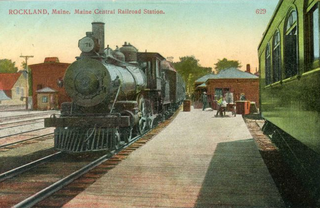
Rockland station is a railway station located at Union and Pleasant Streets in Rockland, Maine. It is the eastern terminus of the Rockland Branch, a state-owned track connecting Rockland and Brunswick. The historic station building was built in 1917 by the Maine Central Railroad, and was listed on the National Register of Historic Places in 1978 as Rockland Railroad Station. It presently houses a restaurant, and served for a time as Rockland's city hall. The line is presently inactive, having most recently had seasonal passenger service from 2004 to 2015 operated by the now-defunct Maine Eastern Railroad. The line would then be leased to the Central Maine and Quebec Railway (CMQ) from 2015 to 2020, then to Canadian Pacific Railway following its purchase of CMQ in 2020. CMQ originally planned to reintroduce service on the line, but not with excursions.

The Connecticut Valley Railroad Roundhouse and Turntable Site is a former railroad facility located in Fort Saybrook Monument Park off Main Street in Old Saybrook, Connecticut. The roundhouse and turntable were built in 1871 by the Connecticut Valley Railroad, which was later acquired by the New York, New Haven and Hartford Railroad. The rail facilities are built partly on the archaeological remains of Fort Saybrook, the main fortification of the 17th-century Saybrook Colony, and are the only surviving remnant of what was once a large facility, with an icehouse, coal bin, steamboat dock, depot, and signal tower. Archaeological remains of these other facilities are believed to lie under other parts of the park and adjacent properties. The exposed facilities were excavated in 1981-2. Both structures were added to the National Register of Historic Places on April 28, 1994.

The Bagby Stationhouse, Water Tanks and Turntable are associated with the Yosemite Valley Railroad (YVRR), which ran from Merced, California to El Portal at the entrance to Yosemite National Park. The railroad operated from 1907 to 1945.

The Bloomington freight station is a historic train station in downtown Bloomington, Indiana, United States. Constructed in the early twentieth century, it has endured closure and a series of modifications to survive to the present day, and it has been declared a historic site. Used only occasionally for many years, it is one of the most important buildings in a large historic district on the city's west side.
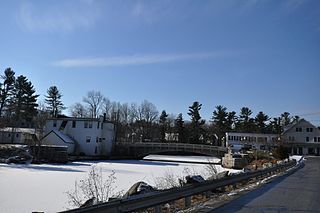
The Goffstown Covered Railroad Bridge was a rare railroad covered bridge in Goffstown, New Hampshire. It was built in 1901 by the Boston and Maine Railroad, on the site of an earlier bridge built in 1850 by the New Hampshire Central Railroad, and carried its tracks across the Piscataquog River in the center of Goffstown. The bridge was listed on the National Register of Historic Places in 1975. It was destroyed by arson in 1976, as would later be the case with the Hillsborough Railroad Bridge in 1985.

The Conway Junction Railroad Turntable Site is the foundational remnants of what was once a major railroad junction in South Berwick, Maine. Consisting of a circular granite railroad turntable foundation and an engine house foundation, it is the only major surviving reminder of Great Falls and South Berwick Railroad. The site was listed on the National Register of Historic Places in 1989.

The Bartlett Roundhouse, also known as the Bartlett Engine House, is a historic railroad service facility in Bartlett, New Hampshire. Located just south of United States Route 302 and east of Pine Street, it consists of a multibay service building and the remains of a 56-foot (17 m) railroad turntable which provide access to the service bays. Built in 1887–88, it is a reminder of the historic importance of the railroad in the local economy. The site was listed on the National Register of Historic Places in 2015, and the New Hampshire State Register of Historic Places in 2008.
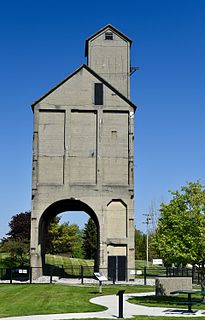
The Grand Trunk Western Railroad Grand Haven Coal Tipple is a coaling tower designed to feed coal to steam locomotives located on the 300 block of North Harbor Drive in Grand Haven, Michigan. It is the tallest structure in the city. The coal tipple was listed on the National Register of Historic Places in 2016.
























